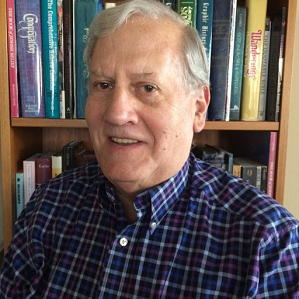Original Developer
Theodore Pincus, MD
E-mail: tedpincus@gmail.com

From his days as an undergraduate at Columbia University in New York City, Dr. Pincus had been interested in analyzing the nature of antibodies involved in immune complex disease. One mentor, Charles Christian, MD, then the head of rheumatology at Columbia, had employed him in his laboratory while he was an undergraduate student.
After receiving his medical degree in 1966 from Harvard Medical School, Dr. Pincus began a surgical residency. But history intervened: It was the time of the Vietnam War, and he joined the Public Health Service to work at the National Institutes of Health (NIH) in lieu of active military duty. While at the NIH, he conducted immunology research under the directorship of Norman Talal, MD, and devised a simpler version of an earlier DNA antibody test that could be used in the clinic to diagnose lupus. “And it worked!” says Dr. Pincus. “That study was published in The New England Journal of Medicine in 1969 and actually, in a sense, set the stage for the rest of my career.”
After his four years of public health service at the NIH, he applied for an internal medicine residency at Stanford. He recalls that Dr. Holman was very gracious about his application and did not require any “remedial” training (as other programs had suggested) after his hiatus from a surgical residency. “That was no problem,” says Dr. Holman. “We didn’t believe in disciplinary lines or required training programs or the like. It was no problem for us to take a smart, engaging surgeon and say, ‘OK, you want to be a doctor in medicine? That’s fine with us.’ ”
In the early 1970s, rheumatology was just emerging as a distinct discipline, “We were interested in people who brought skills and potentially different valuable ideas,” says Dr. Holman, “and [Dr. Pincus] fit right into that category.” After Stanford, Dr. Pincus returned to Cornell for his second year of residency to be near Dr. Christian, who had moved from Columbia to the Hospital for Special Surgery. When he applied for a rheumatology fellowship, he was told that Robert Good, MD, PhD, at Memorial Sloan-Kettering was offering a position as assistant professor in molecular virology research.
He continued his work on deciphering genetic control of viruses at the cellular level at the University of Pennsylvania’s Wistar Institute in Philadelphia as a professor in molecular virology, where was gradually introduced to the joys of clinical work.
In 1980, Dr. Pincus accepted an invitation to develop a rheumatology program at Vanderbilt University in Nashville, and began commuting from Philadelphia to Nashville every Wednesday. Coincidentally, in April of that year, James F. Fries, MD, professor of medicine at Stanford University School of Medicine (Calif.), first publication of the HAQ appeared in Arthritis & Rheumatism. In fact, Dr. Pincus recalls reading the article on the plane to Nashville: “I regarded this as a clinical tool that might improve clinical medicine.”
He immediately began using the questionnaire in his clinics. “I’ve always been interested in measurement in clinical care,” he says. “That’s what my DNA test was about: measurement. So I’ve always been sort of a ‘quant.’ ”
In 1982, Dr. Pincus inherited a box of records from William Sale, MD, an orthopedic surgery resident who was leaving the university for private practice. Filed inside a carton were records from 75 patients with RA who Dr. Sale had studied and assessed in 1973.
“That was very far-sighted,” says Dr. Pincus. “I had nothing to do with the assessment, but it included a whole list of questions about daily living as well as joint exams—basically what we do today, but with a less developed methodology.”
The patients had received injections of thiotepa, an antineoplastic alkylating agent. Dr. Pincus was curious how these patients had fared in the nine intervening years because of concern that there might be an increased risk of cancer associated with alkylating agents. He enlisted the help of a medical student, who contacted the patients whose records were in the box. A physical therapist gave Dr. Pincus lessons on performing function measures (grip strength, walking time, and button test), and he began the follow-up with these patients on Saturdays.
Interestingly, Dr. Pincus was able to account for all 75 of the original study patients. Of the original 75 people, 20 had died—a statistically-significantly higher number than what would have been expected. He also noted severe declines in functional status for almost all the remaining patients. These two findings contradicted the conventional wisdom of the time (based on population studies) that RA was not a severe disease. He also found that premature death in RA could be predicted by two unexpected variables: functional status, as documented on Dr. Sale’s precursor HAQ, and education level.
This was the eureka moment for Dr. Pincus: Outcomes for people with RA could be better predicted by questionnaires than by X-rays or lab tests. His first paper about his findings was initially rejected by many journals; it was then that he realized that promoting the questionnaires as both clinical and research tools would be a struggle.
“I really thought that as soon as I told the world about this thing with the questionnaires that everybody would start using them,” he recalls. “In a sense, the questionnaire was a marker like blood pressure or cholesterol: It could predict premature death.”
He took a three-month sabbatical from his lab to rewrite the paper and refine its methods. The three months turned into 26 years. “I never thought I’d be sitting here, still struggling to convince people to use this. I really couldn’t believe that people didn’t use this questionnaire, and I became a proselytizer for its use” he says.

